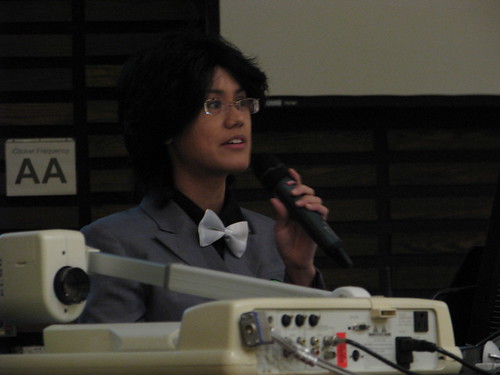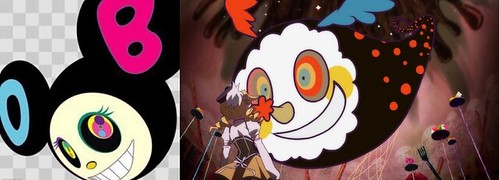Genericon 2013: Into the Witch's Barrier
Superflat and Madoka
 An academic panel at 10 am on a Saturday is better than an academic panel at 8 am on a Saturday; audiences are more likely to be awake if they’re early risers or at least present after having partially recovered from the preceding evening’s debauchery. I’m glad Claudine Castano had a decent turnout for her panel, Into the Witch’s Barrier: Superflat Influences on Puella Magi Madoka Magica.
An academic panel at 10 am on a Saturday is better than an academic panel at 8 am on a Saturday; audiences are more likely to be awake if they’re early risers or at least present after having partially recovered from the preceding evening’s debauchery. I’m glad Claudine Castano had a decent turnout for her panel, Into the Witch’s Barrier: Superflat Influences on Puella Magi Madoka Magica.
If you’ve heard the term superflat but never really looked into what it is, this panel is for you. If you’re a Madoka fan-girl or -boy and want to delve into every aspect of the series, this panel is for you. If you’re an anime or art aficionado looking to broaden your horizons or understanding of the relationship between the two, this panel is for you. According to Castano, the idea for this panel came about when she recognized superflat references in Madoka. When Castano did more research on the style, and in turn learned more about Madoka, this panel was formed in order to let everyone else in on the depth of her newly discovered associations.

Castano started out by explaining the origin of superflat, a postmodernist art movement which was started in Japan by Takashi Murakami. After she introduced a little bit of superflat history, pointing out how the art style was influenced by manga and anime, Castano noted that anime and manga producers, in turn, appreciated the artistic nod and subsequently incorporated superflat into anime and manga. This was a great way to pull the panel together in terms of Superflat and Madoka, but Castano took her time getting to the latter in order to give the audience as much background as possible to enhance their immediate comprehension of the Madoka examples which would follow.
Superflat was explained in terms of its intentions toward blurring the lines between art and reality, where art explodes into the real world; mass production as art; and a revolution against expressionistic repression, exemplified via the juxtaposition of cute and scary imagery. All of that may sound way over-the-top for 10 am on a Satuday, but Castano was adept at saying things simply and backing up each aspect with representative slides or videos. Expertly, those examples were not from Madoka. Instead, the panelist drew examples from such art pieces as Flowers by Murakami; statues; the video for PONPONPON by Kyary Pamyu Pamyu; anime such as Kuuchuu Buranko (Trapeze), Summer Wars, and Panty & Stocking with Garterbelt; and even a collaboration between Tackashi Murakami, Mamoru Hosoda, and Louis Vuitton called Superflat Monogram.
 Then Castano announced the long-awaited transition to looking at superflat in Madoka. There were a couple isolated whoos, but I’d like to take the overwhelming silence as an indication of how swept up the audience was by the flow of the presentation thus far. The examination of Puella Magi Madoka Magica involved the construction of the series, or “the subversion of a magical girl anime;” Kyube’s aesthetic and behavior; as well as several aspects of both the witches and their barriers. After having been offered such a solid backgrounder on superflat, the audience, when called upon by Castano, easily identified multiple examples of superflat in videos of the witches’ barriers. This can only be considered a great success, one that continued past Madoka to show true learning via a highly successful superflat-or-not game that tasked the audience with identifying slides of various artistic endeavors as superflat or not and explaining why.
Then Castano announced the long-awaited transition to looking at superflat in Madoka. There were a couple isolated whoos, but I’d like to take the overwhelming silence as an indication of how swept up the audience was by the flow of the presentation thus far. The examination of Puella Magi Madoka Magica involved the construction of the series, or “the subversion of a magical girl anime;” Kyube’s aesthetic and behavior; as well as several aspects of both the witches and their barriers. After having been offered such a solid backgrounder on superflat, the audience, when called upon by Castano, easily identified multiple examples of superflat in videos of the witches’ barriers. This can only be considered a great success, one that continued past Madoka to show true learning via a highly successful superflat-or-not game that tasked the audience with identifying slides of various artistic endeavors as superflat or not and explaining why.
 I went into panel knowing nothing of superflat other than the term itself and came out with a decent handle on the art style, its history, its influence, and how superflat was used by the producers of Madoka to enhance its own themes. Despite the long wait to get to the direct correlations, the panel felt very balanced between its two subjects. Castano was Livestreaming the presentation, so you can watch the whole thing here for the specifics. The sound quality’s not spectacular, but the content is definitely worth the effort and time (~45 min).
I went into panel knowing nothing of superflat other than the term itself and came out with a decent handle on the art style, its history, its influence, and how superflat was used by the producers of Madoka to enhance its own themes. Despite the long wait to get to the direct correlations, the panel felt very balanced between its two subjects. Castano was Livestreaming the presentation, so you can watch the whole thing here for the specifics. The sound quality’s not spectacular, but the content is definitely worth the effort and time (~45 min).
